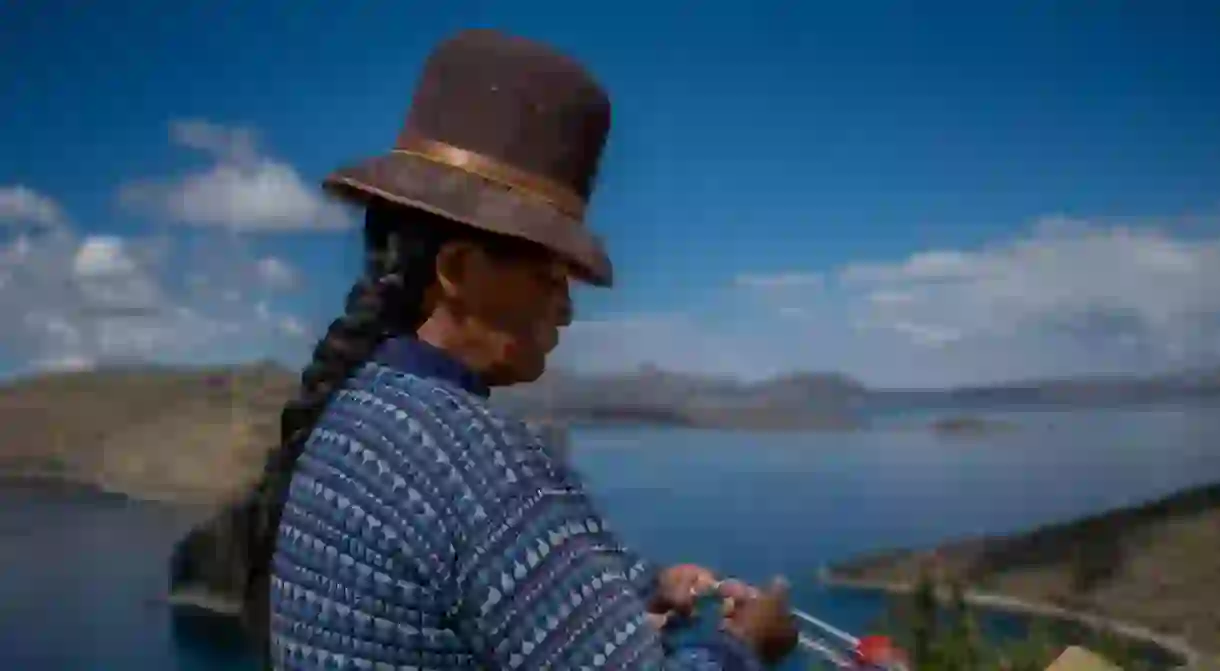Everything You Need to Know About Visiting Isla del Sol, Bolivia

Known as the birthplace of the sun and the Inca bloodline, Bolivia’s Isla del Sol – meaning “Island of the Sun” in Spanish – is deemed one of the most sacred islands in South America. Just an hour’s boat ride from Copacabana, today travelers can visit the island to explore Inca ruins, learn ancient weaving techniques, and take in some of Lake Titicaca’s best views. Here’s what you need to know.
There’s a north/south divide
Despite having a tiny population, Isla del Sol is made up of three communities: the Yumani living in the south, the Cha’llapampa in the north, and the Cha’lla in the central eastern coast. In recent years, there have been growing disputes between the three communities over tourism on the island. At the time of writing, the north side (where the Gold Museum and some of the ruins are located) has been closed off to tourists until the issues are resolved. This is not to say you shouldn’t visit the island (most accommodation options are in the south, as well as many of the tourist attractions), but just check out the situation before you book anything.
Day trip or overnight stay?
Isla del Sol is slow, laid-back island life at its best. In terms of “ticking off” all the tourist attractions (particularly now that the north side is off limits), you could definitely do it all within a day. Having said that, if you’re looking for a couple of romantic nights of beautiful sunsets, serene country hikes, and impressive Lake Titicaca views (as well as a unique insight into Bolivian culture), then it’s definitely worth stopping a while. It’s also worthwhile stopping off at Isla de la Luna on the way, another sacred island nearby with stunning views of the Andes.

Accommodation and facilities are basic
If you do decide to stay the night, be aware that there are currently no luxury accommodation options. Despite growing tourism, life on Isla del Sol is still very much as it was hundreds of years ago, meaning no Wi-Fi, limited electricity and hot water, and certainly no soaking jacuzzi bath. A stay here is about disconnecting from the outside world, getting out into the great outdoors, and experiencing a fascinating way of life. When you have that, who needs luxury anyway?

Come prepared for extra charges
Even if you’re coming over on an “all-inclusive” day trip, it’s a good idea to bring some Bolivianos with you. Although prices are affordable on the island, there are a couple of charges that sometimes catch travelers out. For example, you’ll need to pay 15 Bolivianos (US$2.15) to enter Yumani, 30 bolivianos if you’d like a guide (who usually makes himself known on the boat or on the jetty), and a couple of Bolivianos for the use of toilets. Also note that if you photograph the residents, you should tip them. It’s a basic expectation, and many locals can get quite upset if you refuse. Either way, be sure to ask their permission before taking the shot.

There’s a steep climb in store…
Now that the north side of the island is off limits, the boat only stops at the Yumani community on the south side, which requires a steep climb up from the boat jetty to the top of the island. If you’re staying the night, your hostel may be located even further up the hill and, as there are no cars on the island, you won’t have much choice but to walk it. Having said that, as long as you’re acclimatized and in a relatively fit condition, you won’t have any problems. Our advice? Leave your heavy backpack or suitcase in your accommodation in Copacabana and just come with a light daypack.

And a slow, bumpy boat ride
Boats are painfully slow in Bolivia, there’s just no getting around that. Because of this (and thanks to the cramped space inside), you seem to feel every little wave and bump in the lake. If you suffer from motion sickness, best to take some tablets before you board.
Make time for a trout lunch…
Since they introduced trout into the lake in the 1930s, trucha frita (fried trout) has been served in tourists restaurants by the bucketload here. It’s super fresh, great value, and usually comes with a soup starter, a huge side of potatoes and salad, and – even – a dessert of ice cream or bananas with chocolate. The best bit? All the restaurants on the island come with an incredible view of Lake Titicaca and, on a clear day, the snow-capped Andes.

And a spot of shopping
Isla del Sol is known for its incredible hand-woven hats, sweaters, gloves, and jewelry. In fact, if you take a hike along one of the island’s cobblestones paths, you’ll likely see women at work using the backstrap loom, one of the oldest weaving techniques on the planet. Many of these women will be selling their wares to tourists, often at the fraction of the price that you’d find on the mainland. A purchase from these ladies gets you a bargain souvenir and helps them make a living, so get stuck in!














